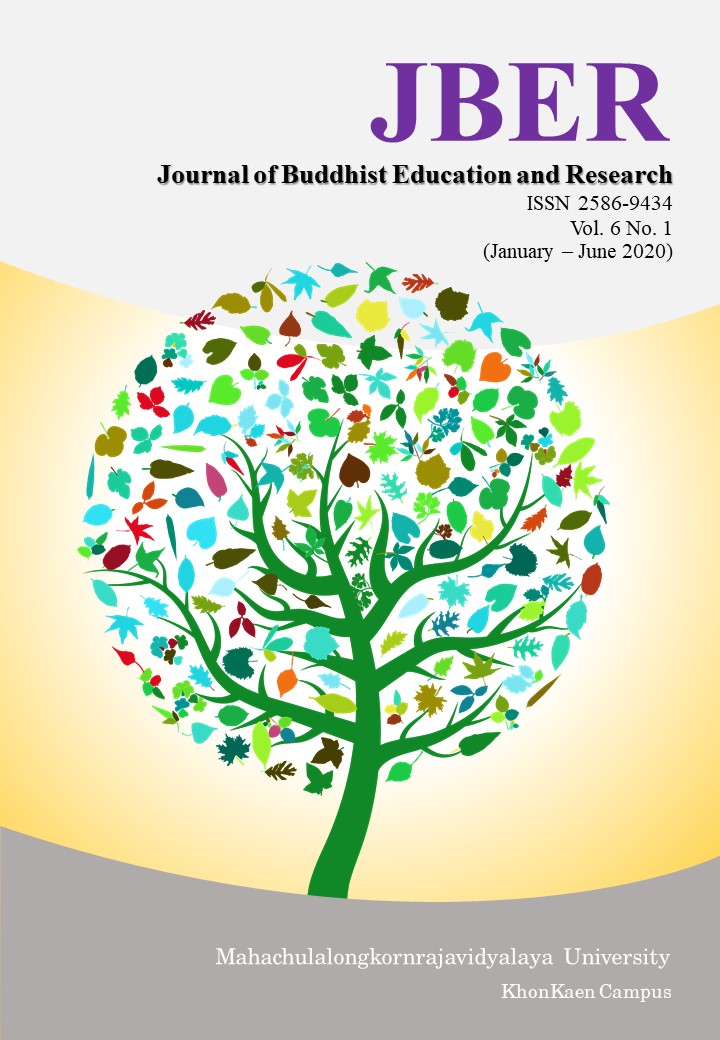LEARNING MANAGEMENT ACCORDING TO THE FOUR IDDHIPADA DHAMMAS IN PHRAPARIYATTI-DHAMMA SCHOOLS GENERAL EDUCATION DEPARTMENT LOWER SECONDARY SCHOOL, UBON RATCHATHANI PROVINCE
Keywords:
Learning Management, The Four Iddhipada Dhammas, Phrapariyatti-dhamma Schools, General Education DepartmentAbstract
The aims of this research were: to study the conditions, to compare and to propose the suggestions for the learning management methods according to the Four Iddhipada principles (iddhipāda, path of accomplishment) in Phrapariyatti-dhamma schools, General Education Department, Lower secondary school level, Ubon Ratchathani province. The study was carried out by means of a mixed research methodology. In the quantitative research, the samples were 38 monk teachers and 32 householder teachers from Phrapariyatti-dhamma school, General Education Department, Ubon Ratchathani province, obtained by simple random sampling according to the table of Krejcie & Morgan. The research instruments were a questionnaire and an interview form. The statistics used in data analysis were: Frequency, Percentage, Standard Deviation, t-test (independent) and F-tests. For the qualitative research, the target groups included 15 informants selected by purposive sampling and in this process, its data collection tool was an in-depth interview form. The data were interpreted by the descriptive data analysis and written in the form of context analysis.
The research results were as follows:
1.The conditions of the learning management methods according to the Four Iddhipada principles in Phrapariyatti-dhamma schools, General Education Department, Lower secondary school level, Ubon Ratchathani province in overall were rated at a high level of practice. The studied aspects were ranked from that of 1) Vīmaṁsā (Investigation), 2) Chanda (aspiration), 3) Citta (thoughtfulness) and 4) Viriya (energy).
2.The comparative results of the learning management methods according to the Four Iddhipada principles in Phrapariyatti-dhamma schools, General Education Department, Lower secondary school level, Ubon Ratchathani province, classified by the samples’ status in overall showed indifference in its practice. Classified by the studied aspects, Viriya had the differences in practice at the statistical significance level of .05; consistent with the set hypothesis. Classified by their education, in overall, there was no difference found but divided by the aspect of Viriya, the difference was found at the significance level of .05; consistent with the set hypothesis. Classified by work experience, there was no difference but for the thoughtfulness aspect, the difference of its practice was seen in the significance level of .05.
3.The suggestions for the learning management methods according to the Four Iddhipada principles (iddhipāda, path of accomplishment) in Phrapariyatti-dhamma schools, General Education Department, Lower secondary school level, Ubon Ratchathani province are that 3.1) aspiration: there should focus on learning management that makes students aware and interested in learning; 3.2) energy: there should focus on managing a variety of learning, encouraging the students to want to learn; 3.3) thoughtfulness: there should focus on teaching the learners to creatively and systematically think and reasonably analyze; 3.4) investigation: there should focus on teaching students to use their intelligence to solve problems rationally.
References
ไทยรัฐฉบับพิมพ์. (2563). ปั้นเยาวชนให้มีความรู้คู่คุณธรรม. สืบค้นเมื่อ 15 มีนาคม 2562.จาก https://www.thairath.co.th/news/society/1799619.
พชร แสงเพชร. (2558). การจัดการเรียนรู้เพื่อพัฒนาคุณลักษณะอันพึงประสงค์ของนักเรียนตามหลักอิทธิบาท 4 โรงเรียนพระปริยัติธรรม แผนกสามัญศึกษา กลุ่มที่ 1 กรุงเทพมหานคร. วิทยานิพนธ์พุทธศาสตรมหาบัณฑิต สาขาวิชาพระพุทธศาสนา. มหาวิทยาลัยมหาจุฬาลงกรณราชวิทยาลัย.
พระมหาฉัตรชัย ธมฺมวรเมธี (ทันบาล). (2560). ศึกษาการจัดการเรียนการสอนตามหลักอิทธิิบาท 4 สำหรับนักเรียนระดับชั้นมัธยมศึกษาตอนปลาย เขตดอนเมือง กรุงเทพมหานคร. วิทยานิพนธ์พุทธศาสตรมหาบัณฑิต สาขาวิชาการสอนสังคมศึกษา. มหาวิทยาลัยมหาจุฬาลงกรณราชวิทยาลัย.
พระมหาบรรจง ติสรโณ (ศรีสุข). (2560). ศึกษาการประยุกต์ใช้หลักอิทธิบาทธรรม 4 ในการจัดการเรียนการสอนของโรงเรียนปริยัติคุณรสวิทยา อำเภอเมืองสุรินทร์ จังหวัดสุรินทร์. วิทยานิพนธ์พุทธศาสตรมหาบัณฑิต. มหาวิทยาลัยมหาจุฬาลงกรณราชวิทยาลัย.
ไพฑูรย์ พิมดี และคณะ. (2560). การพัฒนาการศึกษาภายใต้กรอบประเทศไทย 4.0 สู่ศตวรรษที่ 21. วารสารครุศาสตร์อุตสาหกรรม. 16(2), 199-206.
ลักขณา สิริวัฒน์. (2559). การประยุกต์ใช้อิทธิบาท 4 ในการจัดการเรียนรู้ที่เน้นผู้เรียนเป็นสำคัญของครูระดับประถมศึกษา. วารสารศึกษาศาสตร์ มหาวิทยาลัยมหาสารคาม. 10(2), 163-170.
สำนักเขตการศึกษาพระปริยัติธรรมแผนกสามัญศึกษา เขต 2. (2562). หลักสูตรพระปริยัติธรรม. สืบค้นเมื่อ 15 มีนาคม 2562. จาก https://www.debsecond.org.
Krejcie, R. V. & Morgan, D. W. (1970). Determining Sample Size for Research
Activities.Educational and Psychological Measurement.





